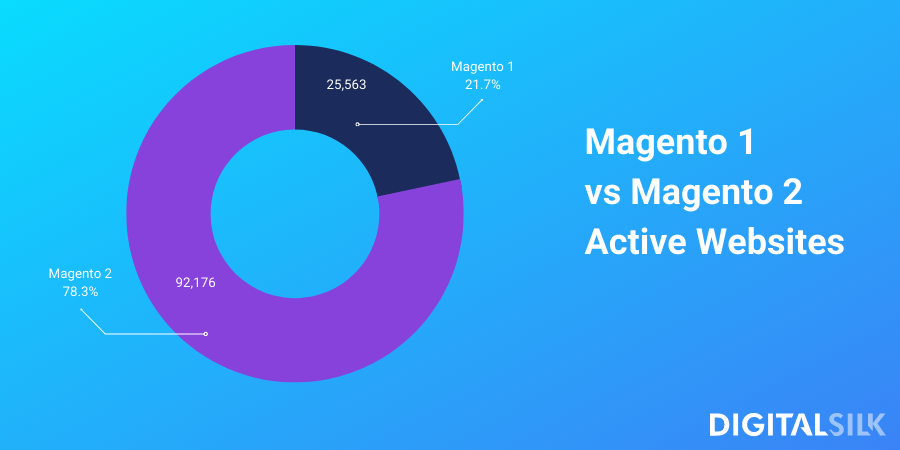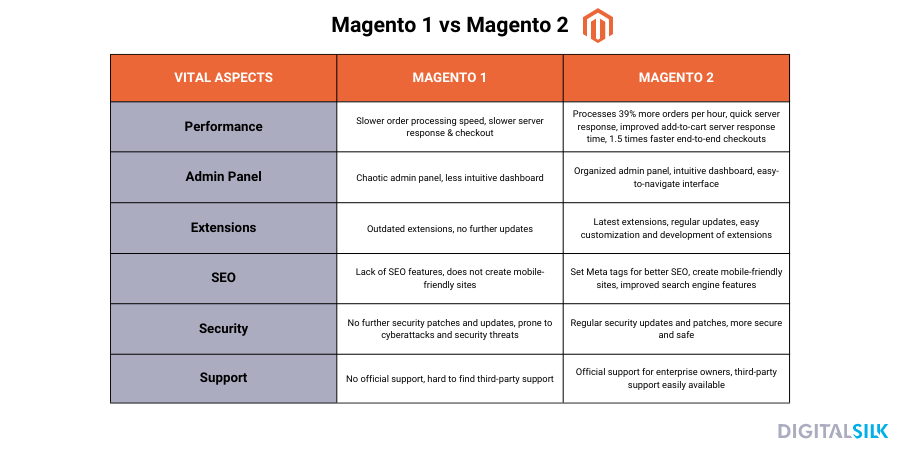There are around 25,563 websites that still run on Magento 1. If your website is one of them, you’re missing out on the improved performance, enhance features and streamlined user interface that Magento 2 has to offer.
We’ll dive into the Magento 2 upgrade to explain what it brings to the table and why you should consider migrating your e-store to the newest version.
From enhanced performance to a streamlined admin interface, here’s what you can expect from your upgrade.
[ez-toc]
Digital Silk builds custom Magento websites. Request a quote
Why Do You Need A Magento 2 Upgrade?
As of June 2020, Magento 1 users are no longer receiving any official support from Adobe. This means you won’t receive any new security patches and your website will be an easy target for malware attacks.
It’s important to know that each security patch is an answer to the threat or vulnerability that was not discovered prior to the initial software release.
But this is not the only reason for migrating your website to Magento 2. Here are four other advantages of switching to Magento 2:
- Improved performance: The latest version of Magento 2 is optimized for speed and performance, resulting in faster loading speed for your online store.
- Enhanced features: The latest version of Magento 2 introduces a range of new features and functionalities that can enhance the overall functionality of your online store.
- Streamlined user interface: Magento 2 comes with a more modern and user-friendly interface, making it easier for you to navigate and manage your online store.
- Future compatibility: By upgrading to Magento 2, you ensure compatibility with future Magento releases, giving you access to ongoing support, updates and new features as they are introduced.
Magento 2 Upgrades
Let’s see what upgrades in particular come with the newest Magento release.
1. Security Upgrades
The Magento 2.4.6 version introduced crucial security updates and platform improvements, including:
- Eight additional security fixes for safeguarding customer data from unauthorized access, ensuring a secure environment for online transactions.
- Stabilized reCAPTCHA for ensuring a steady checkout process, effectively preventing any interference or suspicious activities during transactions in your eCommerce store.
- Comprehensive inspections are performed across grid views, mass actions and exports, providing optimal coverage for admin logs. This enhanced monitoring capability allows your administrators to closely track activities and identify any shady behavior.
2. Platform Upgrades
The Magento 2.4.6 platform upgrades come with enhancements and compatibility with high-performing PHP 8.2.
PHP 8.2 offers various optimizations, including faster execution times and reduced memory consumption, resulting in faster page load times and enhanced overall website performance.
It is important to note that the Adobe Commerce 2.4.6 upgrade does not support the older version of PHP 7.4.
3. Scalability Upgrades
With the latest upgrades in Magento 2, you can now experience improved scalability that streamlines operations involving a large number of customer segments.
This means that tasks such as handling and organization of customer data based on specific criteria or attributes processing customer segments are completed in a shorter amount of time.
If your store caters to a substantial customer base or relies heavily on customer segmentation for marketing or personalization strategies, you will find these scalability upgrades to be very helpful.
4. Accessibility Upgrades
Magento 2 introduced several important accessibility advancements to improve the user experience for individuals with visual, hearing and other impairments, including:
- Sign-in button: The text label of the sign-in button is now aligned with its accessible name, making it easier to identify and interact with for users relying on assistive technologies, such as a screen reader.
- Descriptive button names: Buttons on the store frontend now have descriptive names, enhancing usability and accessibility by providing clear information about what their functions are.
- Verbal descriptive labels: The “Has Video” checkboxes in search filters now include verbal descriptive labels. These descriptive labels provide additional information that enables screen reader users to understand the filtering options available to them.
- Keyboard-only mode: The store frontend can now be accessed and navigated using only the keyboard. This improvement ensures that individuals who rely on keyboard navigation only can now fully interact with the website’s content.
- Improved screen reader compatibility: Screen readers now announce a successful user login, provide total item count in search results and indicate required input fields, enabling users with visual impairments to better understand and interact with the website.
- Improved sub-navigation accessibility: Sub-navigation links are now accessible via keystrokes, making it easier for users relying on keyboard navigation to access and navigate through sub-pages.
These accessibility improvements in Magento 2 aim to cater to the needs of users with special requirements, ensuring a more inclusive and user-friendly experience for all individuals interacting with your platform.
5. Performance Upgrades
Magento 2 made several performance upgrades aimed at improving speed and efficiency, including:
- Category tree processing: The category processing system has been optimized to handle nested children’s tree more efficiently. This means that the system can now handle categories that have sub-categories (like branches of a tree) more efficiently. As a result, you’ll experience faster loading times and better performance, allowing you to navigate and organize your categories more quickly and smoothly, making it easier to manage your online store’s product organization.
- Bulk cart operation response time: The query response times for bulk cart operations have been optimized. This improvement (along with an enhanced inventory management system) allows for the smooth addition of 500+ simple or configurable products to the shopping cart.
- Limit item number in the grid: This feature significantly enhances performance, particularly for stores with large product catalogs. Store administrators can now control the maximum number of products displayed in the grid using a system configuration setting, resulting in smoother product catalog management.
- Faster imports: Faster imports allow you to bring in large amounts of data more rapidly than before. You will be able to handle up to 100,000 records per minute, making it more efficient and saving you time when updating or adding new data to your system.
- Quick order processing for cloud users: Cloud users who experience high order volumes (over 1000 orders per minute) can now improve order processing performance by distributing the load across different database nodes. This helps ensure quick and efficient order processing even during peak times.
- Enhanced cache efficiency: Full-page cache is no longer flushed when an order is fulfilled unless it contains out-of-stock products. Category page caches remain intact when in-stock product quantities change, allowing these pages to load more quickly from the cache rather than being regenerated.
6. Extensions
Magento 2 introduced several extensions that improve the overall eStores’ performance. Here’s what’s new.
Magento 2 Log Download:
- This extension allows store owners to view and download log details easily from the admin panel.
- Complete log details can be accessed and viewed in the log viewer from within the admin panel.
- Store owners can download logs effortlessly without navigating to the var/log folder each time.
Magento 2 Out of Stock At Last:
- This extension rearranges out-of-stock products to the end of the product listing.
- Helps reduce conversion drops by prioritizing available products.
Magento 2 Category Import Export:
- Allows administrators to import or export categories directly using a CSV file.
- Enables quick import/export of categories without data loss.
- Suitable for multi-store views, facilitating efficient category management.
Magento 2.4.6 Release Notes
The latest Magento 2 release includes several improvements, such as:
- Eight security fixes in total + platform security improvements. You can find more details at Adobe Security Bulletin.
- Patched gaps in Admin action logs with more rigid admin action checks.
- Outdated JavaScript libraries have been updated to the latest versions, with outdated dependencies removed, while maintaining backward compatibility.
- The system has undergone refactoring to improve loading response time, resulting in faster and more efficient operations.
- Merchants can now easily search and manage more than 1500 categories without any issues.
- A new setting has been introduced to limit the number of products displayed on the product grid. The default limit is set to 20,000, and this restriction only affects product collections using UI components.
- The Sign in button’s visible label is now aligned with its accessible name, resulting in improved accessibility.
- Full accessibility has been achieved for users who rely solely on keyboard navigation, ensuring all storefront page functionalities are accessible.
- Improved response times for querying products in categories with enabled category permissions and multiple customer groups or shared catalogs.
- Pay Later buttons and banners are now enabled specifically for Italy and Spain, expanding the availability of this feature.
Magento 2 Upgrade Service Steps
The following steps provide a general framework executed by Digital Silk professionals to deliver a complete Magento 2 migration service.
However, it’s important to note that the specifics may vary depending on your website’s unique requirements.
1. Analysis & Planning
The first step is to analyze your current website and plan the upgrade process. This involves understanding your requirements, assessing the compatibility of your existing setup, and determining the necessary steps for the upcoming upgrade.
2. Environment Setup Development
A separate environment is created to minimize downtime and enhance security. This environment replicates the required infrastructure, including server configurations, software dependencies and extensions.
3. Data Backup
Before proceeding with the upgrade, a full backup of your website’s data must be done. This ensures that your data is protected and can be restored in case of any issues during the upgrade process.
4. Magento Upgrade
The Magento 2 version is upgraded in the development environment. This involves installing the new Magento version and migrating your existing configurations, themes, extensions and data to the upgraded platform.
5. Theme & Design Migration
If you have a custom theme or design, it may require modifications to be compatible with the new Magento version. This step involves migrating and adapting your theme to ensure a consistent and visually appealing website after the upgrade.
6. Extension Compatibility Check & Update
Third-party extensions and customizations are reviewed for compatibility with the new Magento version. Any incompatible extensions are identified, and updates or alternative solutions are implemented to ensure smooth functionality.
7. Testing & Quality Assurance
Rigorous testing is conducted to ensure that all website functionalities, including checkout processes, payment gateways and extensions, work correctly on the upgraded Magento 2 version. Any issues or bugs discovered during testing are resolved.
8. User Acceptance Testing (UAT)
Before deploying the upgraded website to the live environment, a UAT phase is conducted where you can review and test the upgraded website to ensure it meets your expectations and requirements.
9. Data Migration
If there are any new or updated data that needs to be transferred from the live website to the upgraded environment, final data migration is performed to ensure that the latest information is available on the upgraded Magento 2 version.
10. SEO Audit
Before going live, an SEO audit is necessary for ensuring that your website’s visibility and traffic don’t get lost during the migration. 301 redirects will be implemented to ensure proper redirection of your old URLs to the new ones. Additionally, internal links will be updated to reflect your new URL structure and to avoid broken pages.
11. Go Live
Once all the necessary steps have been completed, the upgraded website is deployed to the live environment. This involves switching the domain or updating the existing website to the upgraded version while minimizing any potential downtime.
Magento 1 vs. Magento 2: What’s The Difference?
The main difference between Magento 1 and Magento 2 lies in their improved performance, functionality, support and enhanced security in the later version.
So it’s no wonder that a majority of Magento-powered websites, or 92,176 to be exact, are running on Magento 2.

Magento 2 has addressed the shortcomings of the older version by introducing quite a few new features and functions.
To provide a comprehensive overview, let’s compare Magento 1 and Magento 2 across various aspects:
1. Performance:
- Magento 1: Slower order processing speed, slower server response & checkout.
- Magento 2: Processes 39% more orders per hour, quick server response, improved add-to-cart server response time, 1.5 times faster end-to-end checkouts.
2. Admin Panel:
- Magento 1: Chaotic admin panel, less intuitive dashboard.
- Magento 2: Organized admin panel, intuitive dashboard, easy-to-navigate interface.
3. Extensions:
- Magento 1: Outdated extensions, no further updates.
- Magento 2: Latest extensions, regular updates, easy customization and development of extensions.
4. Search Engine Optimization:
- Magento 1: Lack of SEO features, does not create mobile-friendly sites.
- Magento 2: Set Meta tags for better SEO, create mobile-friendly sites and improved search engine features.
5. Security:
- Magento 1: No further security patches and updates, prone to cyberattacks and security threats.
- Magento 2: Regular security updates and patches, more secure and safe.
6. Support:
- Magento 1: No official support, hard to find third-party support.
- Magento 2: Official support for enterprise owners, third-party support easily available.

Migrating from Magento 1 to Magento 2 is highly recommended to leverage the advantages offered by the latest version and meet the evolving demands of the eCommerce world.
Digital Silk offers Magento migration services. Schedule A Consultation
Magento 2 Upgrade Challenges
Upgrading from Magento 1 to Magento 2 can come with a number of hurdles.
But don’t worry – Digital Silk is here to help you prepare your business for the smoothest transition possible.
To help you get ready for what lies ahead, please review the following 6 most common challenges we see when we’re migrating Magento websites:
1. Data Migration
Moving your data from Magento 1 to Magento 2 can be complex and time-consuming since data structures and database schemas differ between the two versions.
2. Extension Compatibility
Many extensions and customizations developed for Magento 1 may not be compatible with Magento 2. This can require you to find alternative extensions or invest in custom development to replicate the functionality.
3. Theme & Design Migration
Magento 2 introduced a new theme structure and layout system, which means that your existing Magento 1 themes cannot be directly migrated. Your themes and designs need to be redeveloped or customized to work with the new structure.
4. Code Customizations
Your code customizations made in Magento 1 may not work as-is in Magento 2 due to architectural and codebase differences. These customizations will need to be reviewed, modified and rewritten to be compatible with Magento 2.
5. Performance Optimization
Magento 2 offers improved performance compared to Magento 1, but optimizing the performance of the upgraded store can still be a challenge. You might need to tune the configuration, manage cache and optimize your server to achieve optimal performance.
6. Testing And Quality Assurance
Thorough testing is crucial for ensuring that your upgraded store functions properly. The testing process should cover all aspects, including functionality, integrations, extensions and performance. This can be time-consuming, especially if you run a complex and heavily customized store.
Digital Silk offers customized solutions. Request a quote
Perform Your Magento 2 Upgrade With Digital Silk
At Digital Silk, our certified Magento experts will help you perform a smooth and successful Magento 2 upgrade.
Why Choose Digital Silk for Your Magento 2 Upgrade?
- Expertise and early adoption: We pride ourselves on being at the forefront of industry knowledge and staying updated with the latest changes in Magento. Our team is among the first to learn about the new features and improvements in the latest Magento versions, ensuring efficient work with the latest technology.
- Strict adherence to Adobe’s recommendations: Following Adobe’s officially recommended process is our standard practice. We understand the importance of a seamless upgrade process, and by adhering to Adobe’s guidelines, we ensure that your site does not face any unnecessary challenges or complications during the upgrade.
- Commitment to security: Security is our top priority. We make sure to install the latest security patches, providing you with a secure and protected website after the upgrade.
- Zero downtime: We understand that time is money. During the Magento upgrade process, we ensure zero downtime. Our experienced team implements efficient strategies to minimize disruption to your website and ensure a smooth transition without any interruptions to your online operations.
- Preservation of data: Data loss is a major concern during upgrades. We guarantee the safe and accurate transfer of all your important information. You can trust us to preserve your valuable data during the upgrade process.
- Dedicated support: We provide dedicated support for two months after the upgrade, ensuring that you are fully satisfied with the results. Our team is ready to address any concerns or questions you may have during this period, providing you with the necessary assistance to make the most of your upgraded Magento 2 platform.
Our experienced team will ensure a smooth transition, enhanced performance and unwavering security for your Magento 2 store. Contact us today to unlock the full potential of your Magento eCommerce store.
"*" indicates required fields








